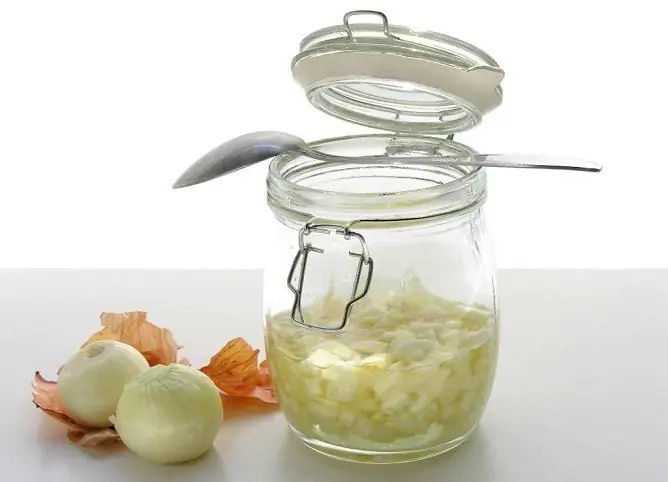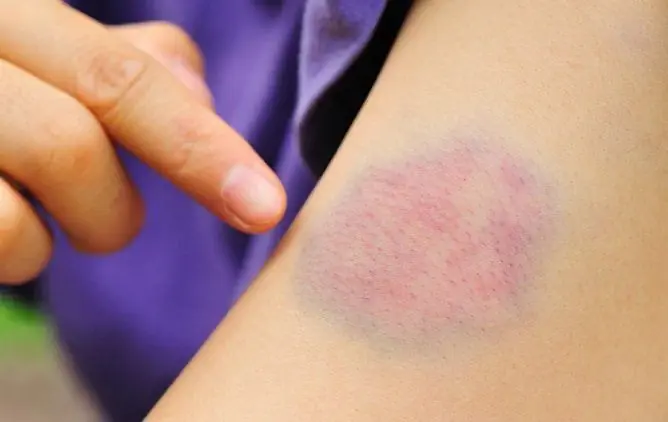- Author Rachel Wainwright [email protected].
- Public 2023-12-15 07:39.
- Last modified 2025-11-02 20:14.
Treatment of adenoids in children with folk remedies: the most effective and safe home remedies
The content of the article:
- How do folk remedies for adenoids work in children
-
The most effective folk remedies for the treatment of adenoids in children
- Kalanchoe or aloe juice
- Field horsetail
- Oak bark
- Sea buckthorn oil
- Propolis
- Carnation
- Eucalyptus oil
- Warming up the nose with a Minin lamp
- Other treatments
- Causes of adenoids
- Disease stages and approach to treatment
- Video
Treatment of adenoids in children with folk remedies is quite effective in the early stages. Pathology is one of the common diseases of childhood, besides, the process can last for years, so it is not surprising that many mothers are looking for an answer to the question of how to cure the disease, and whether it can be done at home.
Adenoids (adenoid vegetation, adenoid growths) - pathological hypertrophy of the lymphoid tissue of the pharyngeal tonsil, located in the nasopharynx. Adenoids can be accompanied by adenoiditis - inflammation of the hypertrophied pharyngeal tonsil. The disease usually affects children from 3 to 6 years old, rarely occurs in adults, as a chronic process that began in childhood and is untreated.

Treatment of adenoids in children with traditional medicine can be effective if carried out under the supervision of a physician
If the treatment with folk remedies is carried out correctly, then you can not only stop the further growth of the pharyngeal tonsil, but also achieve regression of the pathological process and, thereby, do without surgery.
It is important to note that treatment with alternative methods, like any other, requires agreement with a doctor. The assertion that traditional medicine, unlike pharmacy ones, is completely safe is nothing more than a myth, especially harmful when it comes to treating children. Such drugs have no less, but greater potential allergenicity than pharmaceuticals, besides, each of them has its own indications and contraindications, which depend not only on the disease, but also on the child's age, on the stage of the pathological process, on concomitant diseases.
How do folk remedies for adenoids work in children
Medicines prepared according to traditional medicine recipes provide the following effects in the treatment of adenoids:
- eliminate nasal congestion and thereby improve nasal breathing;
- reduce swelling of the pharyngeal tonsil;
- suppress the activity of the inflammatory process, thereby preventing exacerbations of chronic adenoiditis;
- contribute to the sanitation of the focus of inflammation;
- increase local immunity.
The systematic use of folk remedies can alleviate the symptoms of the disease, improve nasal breathing and thereby eliminate hypoxia, and prevent the development of complications.
The most effective folk remedies for the treatment of adenoids in children
The following are effective and safe medicines that can be prepared at home. However, before using any of them, you need to make sure that it does not cause an allergic reaction in the child.
Kalanchoe or aloe juice
The juice of both of these plants has a pronounced bactericidal, decongestant and absorbent effect. Its use allows you to suppress an acute or aggravated inflammatory process in the pharyngeal tonsil.
Before using the juice, the nasal cavity is washed with a solution of table salt (the solution is prepared by stirring a teaspoon of salt without a slide in a glass of warm boiled water). After that, juice is squeezed out of the aloe or Kalanchoe leaf and 3-5 drops are instilled into each nostril. The procedure is performed once a day for two months. After that, you need to take a break, and then the course can be repeated again.
According to reviews, rinsing the nose with aloe juice diluted with boiled water in a ratio of 1: 3 has a good effect on adenoids. Washing should be performed 2 times a day for 15 days.

Aloe juice is one of the popular traditional medicines used to treat adenoids.
Field horsetail
In the therapy of adenoids, several preparations from horsetail are used:
- Broth. Pour two tablespoons with a slide of medicinal raw materials with a glass of boiling water. Heat in a water bath for 8-10 minutes. Insist for two hours. After that, the broth should be filtered through cheesecloth and taken orally 3 times a day, 70-100 ml. This remedy is contraindicated for children under 5 years of age.
- Infusion of echinacea and horsetail. Mix equal amounts of horsetail and echinacea. Pour one tablespoon of the resulting mixture with a glass of boiling water and leave for 40-50 minutes. Strain. Add two teaspoons of honey to the resulting infusion. Take 50 ml orally 3-4 times a day.
- Infusion of horsetail and chamomile. Mix equal amounts of chamomile flowers and horsetail herb. Pour two tablespoons of raw materials with half a liter of boiling water. Insist for two hours, drain. The resulting infusion rinse the nasal cavity 2 times a day.
The course of treatment with any of the described preparations for horsetail is 10-12 days. During treatment, vitamin preparations, which include B 1, should be taken, since horsetail promotes the accelerated elimination of this vitamin from the child's body.
Oak bark
The following collection has a pronounced therapeutic effect for adenoids:
- oak bark - 20 g;
- St. John's wort - 10 g;
- peppermint leaves - 10 g.
Pour one tablespoon of the collection with a glass of boiling water and cook over low heat for 5 minutes. After cooling, the broth is filtered. It should be instilled twice a day, 4 drops in each nostril. The course of treatment is 14 days.
Sea buckthorn oil
Sea buckthorn oil is a storehouse of vitamins and biologically active substances. It has the following effect:
- strengthens the walls of blood vessels;
- reduces swelling of the pharyngeal tonsil;
- suppresses the secretion of mucus and prevents it from accumulating in the nose;
- helps to reduce adenoid vegetation.
For children, two drops of sea buckthorn oil are instilled into each nostril in the morning and evening for three weeks. The duration of therapy is 21 days.
For acute adenoiditis and sore throat associated with associated tonsillitis (inflammation of the tonsils), you can use the following recipe: mix a teaspoon of sea buckthorn oil and three drops of thuja oil. The resulting mixture should be instilled into the nose 2-3 times a day when the clinical symptoms of the disease disappear.
Propolis
Often, traditional medicine recommends using an aqueous solution of propolis to treat adenoids in children. To prepare it, add 20 drops of propolis alcohol tincture (available at the pharmacy) and a quarter teaspoon of baking soda to a glass of warm water. This solution is used to rinse the nose with a syringe or syringe 2-3 times a day.
Propolis ointment is also an effective remedy. To prepare it, you should thoroughly grind a teaspoon of propolis and add 10 teaspoons of unsalted butter to it. While stirring, heat in a water bath until the mixture is homogeneous. Ointment is applied to the nasal cavity 2 times a day.
Carnation
Clove and clove oil have a powerful antiseptic effect, they are used for acute adenoiditis or exacerbation of chronic. Put 10 cloves in a glass of boiling water and leave for one hour. The resulting infusion is used for instilling into the nose 2-3 drops 4-5 times a day until the symptoms of acute inflammation subside.
Eucalyptus oil
Treatment with essential oils has a good effect on adenoids in children. However, it is better to carry out not mono-, but combined therapy with the sequential use of the following oils: eucalyptus, sea buckthorn and cedar. First, use eucalyptus oil for 15 days, instilling 2 drops in each nostril 3 times a day. Then, using the same scheme, sea buckthorn oil is used, followed by cedar oil (you can replace it with tea tree or thuja oil).
Warming up the nose with a Minin lamp
The Minin lamp (blue light lamp) is one of the simplest emitters of infrared waves, whose action is based on heating tissues and activating metabolic processes in them. It can not be used for acute adenoiditis or exacerbation of chronic. Therefore, before using this method of treatment, you must consult your doctor.

Minin lamp, or blue lamp, provides deep tissue heating
Warm up the nose with a Minin lamp 2 times a day for 8-12 minutes. Eyes are covered with a bandage or a towel folded several times. The lamp is kept at a distance of 25 cm from the child's face so as not to cause discomfort.
Treatment courses with folk remedies should be repeated at least twice a year.
Other treatments
For the effective treatment of adenoids in children, it is important to combine methods of local therapy with measures aimed at increasing general immunity. These include:
- daily long walks in the fresh air;
- the choice of clothes for the child according to the weather (both hypothermia and overheating are unacceptable);
- hardening procedures (wiping, dousing, contrast shower, air baths);
- sports (swimming, athletics, daily morning exercises, active games in the fresh air);
- carrying out daily wet cleaning at home;
- the use of air humidifiers (it is especially important to use them during the heating season, as well as in the summer when the air conditioner is running);
- maintaining the air temperature in the room within 19-22 ° С;
- daily inclusion of vegetables and fruits in the child's diet;
- timely and complete treatment of infectious diseases (ARVI, tonsillitis, sinusitis).
Causes of adenoids
The function of the pharyngeal tonsil is to protect against viruses and bacteria from entering the respiratory tract with the flow of inhaled air. However, with a weakened child's immunity, it cannot fully destroy disease-causing agents. As a result, they begin to accumulate on the surface of the amygdala, penetrate into its thickness and cause the development of an inflammatory process - adenoiditis. Acute adenoiditis often becomes chronic. Against the background of chronic sluggish inflammation, lymphoid tissue grows, which becomes the cause of hypertrophy of the pharyngeal tonsil, that is, the formation of adenoids.
Factors that increase the risk of the formation of adenoid growths:
- hereditary predisposition;
- immunodeficiency states;
- childhood infectious diseases (whooping cough, scarlet fever, measles).
Disease stages and approach to treatment
The pharyngeal tonsil is located in the vault of the nasopharynx and normally does not cover the opener. Depending on the degree of its hypertrophy, the following stages of the disease are distinguished:
- The overgrown amygdala covers 1/3 of the opener;
- 2/3 of the opener is closed;
- The entire opener is almost completely closed, there is no nasal breathing.
Traditional methods of treating adenoids in children can be effective only at stage I of the disease. With 2 degrees of adenoid vegetation, alternative therapy is used as one of the constituent parts of a comprehensive treatment. At grade 3, surgical treatment is indicated - adenotomy.
Video
We offer for viewing a video on the topic of the article.

Elena Minkina Doctor anesthesiologist-resuscitator About the author
Education: graduated from the Tashkent State Medical Institute, specializing in general medicine in 1991. Repeatedly passed refresher courses.
Work experience: anesthesiologist-resuscitator of the city maternity complex, resuscitator of the hemodialysis department.
Found a mistake in the text? Select it and press Ctrl + Enter.






